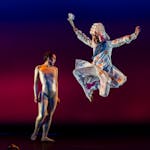Echoing from a 5-foot-tall vintage radio, the voice of Norway's King Haakon VII fills a small room at the American Swedish Institute. It's his national New Year's message at the end of 1945, after ruling in exile during the five-year Nazi occupation.
This moment holds a special place in Norwegian hearts.
"During World War II, the radio, the Norwegian flag, and a lot of other things were banned," said Ethan Bjelland of Norway House, a Minneapolis cultural group that decorated this room to look like a postwar Norwegian Christmas. That "allows us to talk about the war," he said, "but also have important things like the flag on the Christmas tree, and the radio out, instead of hidden in the wall."
This time capsule is one of six in the holiday-themed exhibit "Time Tested. Tradition Approved." The five countries of Scandinavia, plus one guest, each have decorated rooms in the Swedish Institute's Turnblad Mansion.
Sweden imagines the Art Deco boom of the 1920s. Denmark showcases 1960s-'70s Danish Modern design. Iceland explores its recent transformation into a tourist destination. Guest curators celebrate Ireland's own boom in the 1980s-'90s, while Finland visits the future.
We walked through the century-old mansion a couple of weeks ago as the rooms were set up. The times are changing, but there's always something familiar about Christmas.
A family project
"In the future the evergreens don't grow too well because it is going to be too hot and too wet for them, so the ones that are left aren't allowed to be cut for Christmas," said Anita Jain.
A native Finn who immigrated to the United States 45 years ago, Jain curated Finland's room — which imagines the effects of climate change — with her daughter, Minna, also an artist.
Anita's husband, Nirmal, originally from Delhi, wheeled in a "tree" he made out of salvaged lumber and rebar. Minna was busy figuring out the dimensions for one of her two sculptures depicting Joulupukki, the winter deity (aka "Finnish Santa") that inspired our modern-day Santa Claus.
"Joulupukki" is Finnish for "yule goat." And yule itself was a midwinter pagan festival celebrated in many Scandinavian countries. In Minna's rendition, Joulupukki has both a masculine and feminine incarnation. The former is a mannequin with curved goat horns, wearing a lapel of green plexiglass, acrylic and metal (made ideally of repurposed materials), who comes to consume the darkness and despair of the previous year. Another mannequin represents the feminine aspect, who brings light back to the winterbound community. She wears a pink, dangly, shawl-like arrangement of the same materials.
"We thought it was really important to have this element of fear, as the Finns and everyone else around the world is adjusting to great environmental and social change," said Minna Jain.
Down the hall in Ireland, it's the 1980s, when the poverty-stricken country emerged into prosperity as the "Celtic Tiger." Posters from "Riverdance," the Irish music and dance show that toured the world, hang alongside drawings of famous Irish writers. The "Laden Table," set with a candle, a pitcher of milk, bread and sweets, is laid out for Mary and Joseph, or anyone else who needs refuge on Christmas Eve.
Organized by Natalie O'Shea of the Celtic Junction Arts Center, an Irish cultural center in St. Paul, the room is loaded with Irish objects like the Gaelic harp and traditional dance outfits. But it's "Riverdance" that holds the most significance for O'Shea, who met her Dublin-native husband, Cormac, while on tour with the production.
Danish romance
In the mansion's library, Susan Loschenkohl, Susan Jacobsen and furniture designers Danish Teak Classics imagine Denmark of the 1960s.
Eight funky retro lamps, including a white plastic "Cactus" in the shape of a blooming desert flower, hang above a heavy wooden table. On it, a sort of blueprint outlines how the table might be set for a dinner with the Danish royal family, complete with china and silverware.
In a second room, the royal theme continues with a framed photograph from the 1960s of Denmark's Queen Margrethe II and her late husband, Prince Henrik.
Danish Modern wasn't the country's only export to the United States. Loschenkohl's parents, who provided two of the lamps here, had known each other in Denmark, then reconnected when her dad was a U.S. soldier stationed in Germany during the Korean War.
"When she agreed to marry him, he said, 'Oh, by the way, I am an American citizen ... so the catch is we're moving to the U.S.' "
The couple settled in Racine, Wis., a destination for many Danish immigrants. They figured they would only stay a few years, but ended up making it their home.
It wouldn't be Christmas without family, perhaps the real message of the American Swedish Institute's romp through history.






